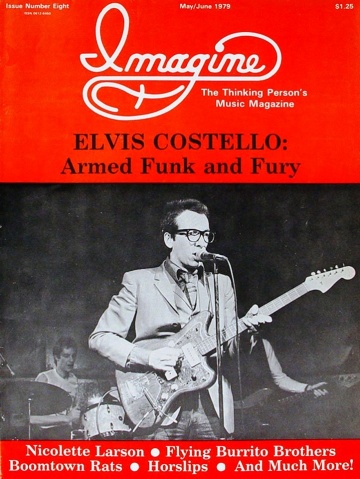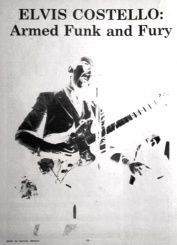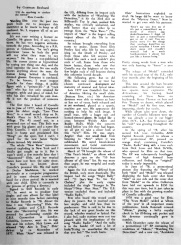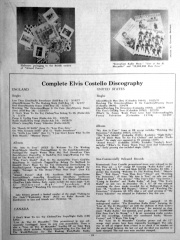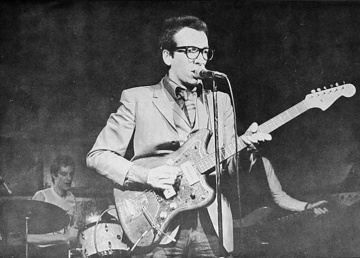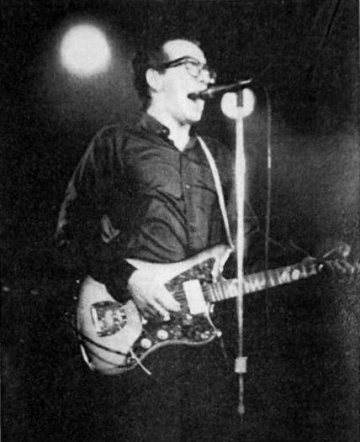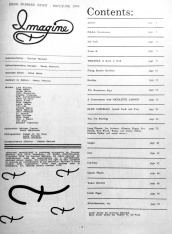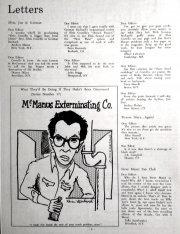|
"I'll do anything to confuse the enemy"
— Elvis Costello
Watching Elvis over the past two years leads me to interpret this statement as he wants to keep us all confused. So, I suppose, all of us are the enemy.
It's not easy writing a feature on Costello. He grants few, if any, interviews. He has very negative attitudes towards the press. According to a P.R. person at Columbia, "he isn't giving interviews because he feels the press will say what they want to say anyway." He lives a non-publicized life. He comes across as hypocritical by saying one thing one day, and the total opposite the next. No one really knows anything about the man: the human being behind the horned rimmed glasses. Everyone is confused.
To be honest, I must respect Costello for these things. A public figure with a "private-life." A "rock star" who has not only retained his integrity, pride and piece of mind, but who has also remained his own man. He is not the product of someone else.
The first time I heard of Costello was in June of 1977, when I happened upon his debut single, "Less Than Zero," in a small record shop on St. Mark's Place in N.Y.'s Greenwich Village. The 45 stood out, in a perverted sort of way. This little man with great big glasses and a name like Elvis Costello. I wish I could say I took it home and proclaimed him "King" on the spot, but I can't. I opted for the new James Taylor album instead. My mistake.
The whole "New Wave" movement started exploding in New York and I finally got caught up in it. But it wasn't until a few months later that I "discovered" Elvis, and my musical tastes have not been the same since.
Not much is known about Costello's personal life. His real name is Declan MacManus, he worked previously as a computer programmer and in some obscure country-rock band for a short period. He is married with one child. (Elvis is currently in the process of getting a divorce.)
Signed to Stiff Records in early '77, he went on to produce four singles and one album for that label in nine months time before switching to Radar Records in '78. About the time I was "discovering" Elvis, the London police and C.B.S. Records were also "discovering" him. He was arrested for performing outside the CBS Convention in London. Columbia, however, went on to sign him and his cohort, Nick Lowe, and released My Aim Is True, Elvis' debut lp in November of 1977. When Aim was released in the U.S., differing from its import only with the inclusion of "Watching The Detectives," it hit the 33rd slot on Billboard's Top lp chart, received little airplay, was critically acclaimed, and sold better than any other lp to emerge from the "New Wave." (The import of Aim is the largest import album of the 70s in this country.)
Its release brought everything from scorn to praise. Scorn from Elvis Presley fans who felt he was capitalizing on the death of Presley, and from those who felt anyone who looked like such a nerd couldn't play rock 'n' roll. Praise from those who knew better, those who saw that Costello was the brightest of the very few bright rock n' roll beacons during this otherwise horrid decade.
His following grew. But so did Elvis. Each new release or tour has shown continued development and maturity of musical and lyrical ideas.
Late 1977 saw Costello's first tour of America. Hitting the small clubs, (Bottom Line, etc.) his American devotees were able to witness an hour or less set of tunes, both released and as yet unreleased, played at a spastic, machine gun rate. His appearance did nothing to help his rock image. A small man, with a baggy suit and horned-rimmed glasses. It looked like a cross between Woody Allen and Buddy Holly. While the concerts ended before you felt they had begun, we all got to take a closer look at this "new" Elvis. He was angry. Angrier than one would think from listening to Aim where it was sublimated. His weird knock-kneed movements and facial contortions accented his lyrical frustrations.
March of '78 brought the release of This Year's Model, an album which deserves a spot on the "10 best albums of all time" list. He was more than angry, he was vengeful and ready to attack.
Again the U.S. release differed from the British, only more drastically. The Import had the songs "Night Rally" and "(I Don't Want To Go To) Chelsea" plus the early copies included the single "Stranger In The House" / "Neat Neat Neat." The U.S. version excluded these and included "Radio Radio."
Few who heard this record could deny its power. But it received even less airplay and sold less than its predecessor. This is said to be due to the lack of any great hooks on this record, whether musical or lyrical. Yet I also feel, radio stations were not too pleased with the implications of the song "Radio Radio:" "And the radio is in the hands / Of such a lot of fools / Trying to anesthetize the way that you feel." The truth hurts.
Elvis' frustrations exploded on vinyl. No longer did he want to know about the "Mystery Dance." Now he wanted to get even with his partners:
"Don't say you love me when it's just a rumour
Don't say a word if there is any doubt
Sometimes I think that love is just a tumour
You've got to cut it out
You say you're sorry for the things that you've done
You say you're sorry but you know you don't mean it
I wouldn't worry
I had so much fun
Sometimes I almost feel just like a human being
Pretty strong words from a man who was only learning to "dance" a year ago.
The release of Model coincided with his second tour of the U.S., only four months after the beginning of his first.
This time around the bars became auditoriums. His performances were less spastic. more expressive. The Attractions, his backup band consisting of Steve Naive on keyboards, Bruce Thomas on bass and Pete Thomas on drums, which played on Model and his first tour, were improving, slowly but surely.
While album sales were down, the number of Costello followers were up. He was already a star in our bigger cities (N.Y., L.A., San Francisco) and his "cult" was growing throughout the country.
In the spring of '78, after his second U.S. tour, Columbia AND Capitol Records joined to release a 12" promotional EP, pressed on orange vinyl, containing Costello's "Radio, Radio" along with a tune each from Nick Lowe and Mink DeVille. who opened for Elvis on that tour. The EP was subsequently bootlegged because of high demand from collectors, and finding an "original" today is nearly impossible.
In June of '78, a promotional picture disc featuring the "best" of both Aim and Model was released displaying the back cover shot from Aim on one side and the covet shot from Model on the other. Collectors have laid out upwards to $150 for this very rare item, but it just takes its place in line with the growing number of Costello collectibles.
1978 was a good year for Elvis. This Years Model ranked as "album of the year" in all important music publications, Linda Ronstadt covered "Alison," placing a hefty royalty check in his ill-fitting suit pocket and his devotees continually grew in number.
With December came the release of a promotional 12" EP containing live renditions of "Alison," "Watching The Detectives" and a new cut, "Accidents Will Happen." Radio stations ate it up. The fuse was lit.
A free limited edition 45, is given away to fans who attended Costello's Christmas gigs in Britain. The tunes, "Wednesday Week" and "Talking In The Dark" are among the best Elvis has written. The former features his first tempo change, going from machine sun rock to swinging pop ("Please Please Me," etc.) Collectors dream of the chance of getting their hands on one of these. The fuse stew shorter.
Shortly thereafter fans discovered Nick Lowe's Import 45, "American Squirm" with Elvis singing background and its flip side, "(What's So Funny About) Peace, Love & Understanding" with Costello singing lead on this old Brinsley Schwarz tune. The bomb was dropped.
It exploded in January with the release of Armed Forces. It became Radio's "Top Add-On" lp and made number 15 in Billboard within three weeks, eventually moving up to number ten.
Critical acclaim was once again unanimous. He did it three times in a row — three perfect albums in less than two years, a feat equaled by no one.
February '79 brought his "Armed Funk" tour and a barrage of incidents, all unbelievable but not shocking, considering his angry past. Everything from lambasting the radio station that promoted one of his concerts to getting in a fight with Bonnie Bramlett, to forcing his audience to leave a concert hall by the use of intolerably loud feedback.
The reviews of this tour have been mixed. At the opening show at the Paramount in Seattle, Washington on February 6th, Elvis seemed like he didn't want to be there. The best performances were given where he liked the city.
The tour climaxed, but not ended, with "Elvis Costello Weekend" in N.Y., consisting of two shows at the Palladium on March 31st and one show each at The Lone Star Cafe, the Bottom Line and Gildersleeves on April Fool's Day. The shows at the Palladium were awesome. Costello made the audience part of the show. At the second show, Elvis played two cuts from Aim ("Alison" and "Watching The Detectives"), three cuts from Model ("The Beat," "Lipstick Vogue" and "Radio Radio"), five cuts from Armed Forces ("Accidents Will Happen," "Oliver's Army," "Green Shirt," "Goon Squad" and "Two Little Hitlers") and three new tracks ("High Fidelity," "Big Opportunity" and "Celibate Girls"). He saved "Mystery Dance" for the first encore, "Pump It Up" and "You Belong To Me" for the second. Yes, he played two encores.
He talked to the audience. Teased them. He even put down his guitar during "Alison" and made his "aim" even clearer. He crawled before the front row during "Lipstick Vogue" and literally blew the audience away during "Detectives." Introducing "Radio Radio" he said "I would like all the radio stations to take this personally. Except WNEW, I don't want them to take this personally, but all the others, take it personally."
He was appreciative of the audience, thanking them many times. But they were also appreciative of him. When Elvis asked everyone to stand they did, and remained standing for the remainder of the evening.
The performance was spectacular. The Attractions were tight and professional. Elvis's vocal ability was in top form. While Naive plays organ, Pete Thomas, drums and Bruce Thomas, bass, Costello's main instrument is his voice. His emotional delivery of every tune including a teary eyed version of "Alison" were, more than anything else, the factors which made this concert.
Of the non-recorded tunes, "High Fidelity" was the standout, not only for its intended play on words, but for its superb refrain of "Can you hear me." If it is any sign of what lp Number Four will be like then those of us who have been predicting Beatle-esque importance for Costello since the beginning can breathe easy once again and not be forced to eat our words. Somehow, I doubt that I will have to eat my prediction that Costello & Lowe will be the next Lennon & McCartney. If anything, that statement is continually being reinforced.
The "Armed Funk" tour ended April 14th in Providence, Rhode Island. What now? According to Bruce Thomas, Elvis has enough material for four albums ready to go. One will surely be in our hands by Christmas this year, if not sooner.
All indications point to Elvis as the rock star of the 80s; in my eyes he even deserves the title for the 70s. I know it sounds cliched, but maybe we should call him the next King of Rock 'n' Roll.
| 
